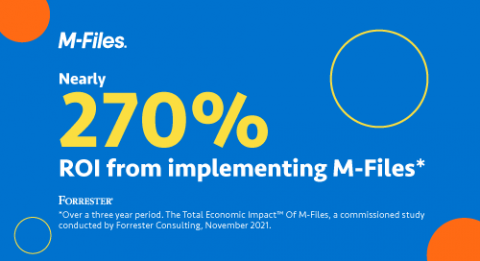Teams | Collaboration | Customer Service | Project Management
Content Management
Connecting Hubshare to M-Files Vault | The Smarter Way To Work
How Intelligent Information Management Affords Nearly 3x ROI for Organizations
In business, if you were to ask a group of executives to name their top five investments which have a measurable positive return on investment (ROI), you would probably see many of the same, usual suspects on their lists: ad programs, salespeople, fulfillment systems, marketing infrastructure, lead generation programs, to cite a few. That checks out. Sales and marketing investments are usually viewed through the lens of ROI, and as well they should. But what about the ROI of technology investments?
The Key to a Successful Digital Transformation in the Work From Home Era
Regardless of the type of business you're talking about, organizations invest in digital transformation for a myriad of different reasons. Some turn to the power of modern technology to improve efficiency - empowering employees to communicate from department to department easier than ever before. Others want to guarantee that data can flow freely across the enterprise, making sure that the critical information that people need to do their jobs is always in the right hands.
The Critical Data Lessons We Learned During the COVID-19 Pandemic
The still-ongoing COVID-19 pandemic has been a challenge for us all, to be sure — but it's also brought with it its fair share of lessons that will continue to be relevant and valuable long after everything has calmed down again. This is particularly true in terms of what it has taught us about data — something that has been an essential part of the response for communities, governments and businesses everywhere.
How to Create Consistent Processes, Even When Working Remotely
Out of all of the major changes to the way we do business that the ongoing COVID-19 pandemic, remote work isn't necessarily one of them. According to a study conducted in 2019, about 99% of respondents said that they would gladly work remotely at least some of the time for the rest of their careers.
The Warning Signs That Your Document Management May Need an Upgrade... or to Be Put Out to Pasture
One of the biggest reasons why most organizations embrace document management in the first place is because they're attempting to solve a number of crucial challenges, essentially all at the exact same time. If your organization is still living in a world of paper-based or even spreadsheet-based processes, simply finding the document you need when you need it can become an uphill battle.
How Gen-Z Is Impacting the Future of How We Work
As a father of a 13-year-old boy, I've often marveled at how different we are when it comes to using technology. Call me old-fashioned, but my son has it good.
Why all Digital Transformation Leaders Have a Mobile-First Information Management Strategy
Even now, lots of businesses first design their website to work on laptops and desktops. Afterwards, they will also make sure those same sites function well enough on phones and tablets, almost like an afterthought. Surprisingly, that's what most people mean when they discuss responsive website design. In an era when even Google has advocated for mobile-first development, such a cart-before-the-horse approach doesn't signal digital transformation leadership.
What is Optical Character Recognition (OCR)?
One of the biggest problems that most organizations deal with these days has less to do with the sheer volume of data they're working with on a daily basis and is more about just how much of it is unstructured. Unstructured data, as the term suggests, is that information that either doesn't have some type of pre-defined model, or that isn't organized in any pre-determined way.






